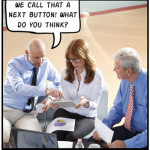One note to the “Burgers and fries” third point.
All fine about it except for the fact the customers and their training consultants in the end could find more convenient and acceptable for the taste… and the pocket, a fast food menu :))
I always asked myself why the market I’m in can be spoiled by some crapid e-learning while, i.e., a lawyer can lose his case and still be considered.
What about the idea of funding an international e-learning designers fraternity?
Ciao a tutti (Hello to everyone)
Myth 1: Rapid E-Learning Is Crapid E-Learning!
July 11th, 2007
In this series, we’ll look at some popular myths about rapid e-learning.
Because the tools are easy to use and just about anyone can create “e-learning” with them, some assert that the tools create bad e-learning. It’s the same argument you hear about PowerPoint. While this might be true about some of the e-learning courses developed with rapid e-learning tools, noted elearning archaeologist, Werner Oppelbaumer, is quick to point out that crappy e-learning existed years before the rapid development tools came on the scene. In fact, he goes on to say that crappy training existed before e-learning was even a form of training.
This isn’t just a recent phenomenon either. Apparently, thousands of years ago, men in bed sheets would pull productive farmers from their fields and bore them with lectures on the nature of justice and the ideal republic.
Look, I’ll admit there’s a lot of bad e-learning out there. I’ve even created some. However, it doesn’t exist because of the tools. It exists because the training isn’t designed well. You cannot blame the tools for poor learning design. The secret is learning to use the tools appropriately. The reality is that having rapid e-learning tools and a strategy to use them is important in today’s business climate.
To get the most out of the tools you need to include sound instructional design and use the tool’s multimedia capabilities to create engaging and interactive training.
- Use a template. One problem with poor e-learning modules is that you have users who aren’t trained instructional designers. It’s important to help them learn some basic instructional design principles. If you cannot spend a lot of time with them, at least create a simple template to help them organize the information. You might not get the most dynamic training course, but it will help move it in the right direction. In addition, don’t underestimate the abilities of your subject matter experts. Most want to do a good job; they just might need a little help.
- Look at what others are doing. You’ll get a better idea of what’s good and bad if you look at what others are doing. There are a lot of examples of e-learning courses and modules. In addition, look at industry award winners.
- Burgers and fries. If I’m in a hurry, I’m more apt to stop at McDonald’s than at a fine French restaurant for a seven-course meal. I wouldn’t make a regular meal of fast food, but many times it’s just what I need….or all I want to invest in. The same can be said for training. Maybe there’s a time where simple click & read training is all you need.
Rapid doesn’t mean crapid! You are in control and can determine the quality of what you produce.
Next, we’ll expose the myth that rapid e-learning is a second class approach to training.
Events
- Everyday. Check out the weekly training webinars to learn more about Rise, Storyline, and instructional design.
Free E-Learning Resources
 |
 |
 |
|
Want to learn more? Check out these articles and free resources in the community. |
Here’s a great job board for e-learning, instructional design, and training jobs |
Participate in the weekly e-learning challenges to sharpen your skills |
 |
 |
 |
|
Get your free PowerPoint templates and free graphics & stock images. |
Lots of cool e-learning examples to check out and find inspiration. |
Getting Started? This e-learning 101 series and the free e-books will help. |
12 responses to “Myth 1: Rapid E-Learning Is Crapid E-Learning!”
I couldnt agree with this article more. We’ve been writing about this for many years, and its important for people to realize that there are two “types” of training (broad generalization of course!) – those that develop skills and competencies, and those which are more informational in nature.
The latter is where 80% of all corporate information needs fall, and many of these are completely unmet by traditional training. When we first coined the term rapid e-learning in 2001, we realized then that many of these “rapidly changing” informational needs were completely unmet by traditional WBT. The problem is still true today – and new technologies like Articulate, blogs, podcasts, and more are breaking this barrier even further.
The other reason that Rapid E-Learning is so important is that it “breaks the bottlenecks” from subject-matter-experts (a topic we wrote about in 2003, when Macromedia got into all this). As you know, most SMEs know PowerPoint well – so why “re-engineer” all their material when you can “repurpose it” or even let them publish it.
Anyway, i’m a 100% supporter of this entire model and as we discuss regularly in our research, instructional designers just have to get comfortable with this “informational” type of content, and feel free to continue to focus on “competency development” programs as a seperate content type (often complimented by rapid e-learning).
Hi, Tom:
I also heartily agree that the crappiness is due to the designer’s lack of imagination rather than the tool! I’m trying to get started with elearning — I wish I could show you the PowerPoints I learned to create while working at Circuit City’s training department for a couple months. They take PowerPoint way beyond anything I’d ever seen, and it could be mistaken easily for a flash animation the way they do it. The key is bringing good graphics in from Photoshop as jpegs, and .pngs with transparent backgrounds (created by a graphic designer, me), and using a lot of custom animation effects.
Thank you so much for your blog!
This article addresses part of the problem with rapid e-learning but does not sufficiently focus on what may be the key problem with all training: bad instructional design. We’ve known for some time already that media alone doesn’t make for good training or education. What makes the difference is how we use it, i.e. how well we understand the nature of the problem to be tackled and then design the right solutions. Rapid e-learning is continually being marketed as a guaranteed quick fix accessible to anyone. I believe that’s a serious misrepresentation of reality. Rapid e-learning works well when those using it understand 2 things: (a) when to use it and what to expect from it; and,(b) how to design effective instruction generally, and computer-mediated instruction more specifically.
In my 30+ years in training and education (including designing e-learning), one fundamental truth has not changed: good training results from good instructional design. Knowing how to use various tools is not enough! Effective rapid e-learning requires as much, and sometimes more, design savvy than other methods (quickly identifying key issues and creating effective learning materials can be quite challenging).
A good carpenter can do marvelous things with simple tools and a bit of time. A lousy carpenter probably won’t accomplish half as much even with the best tools and lots of time. We should remind ourselves and our clients of this as often as possible. The point is not to exclude anyone, scare them away or build cases for ourselves: instead, it’s about educating our clients and focusing on getting the right results, not on using tools.
I have to throw in my two cents as both a training designer and part-time (OK, hobby) carpenter. It amazes me how people think they can design training becuase they have Power Point, but people don’t think they can build a house because they have a hammer. OK, some of them do, but most realize that there special are skills that support the tools, except apparently for training design. That you’re just born knowing. Or maybe you learn it from years of going to school – as it seems the more education someone has (especially in a technical field like science or engineering) the greater their belief that they can design training. By that logic, it seems that from having lived in a house all my life I should know how to build one.
Thanks for letting me vent.
[…] Myth 1: Rapid E-Learning Is Crapid E-Learning! […]
[…] Myth 1: Rapid E-Learning Is Crapid E-Learning! […]
[…] […]
[…] In the first part of this series , we busted the myth that Rapid E-Learning Is Crapid E-Learning . Myth 1: Rapid E-Learning Is Crapid E-Learning! In this series , we’ll look at some popular myths about rapid elearning. elearning: Blending […]









0
comments